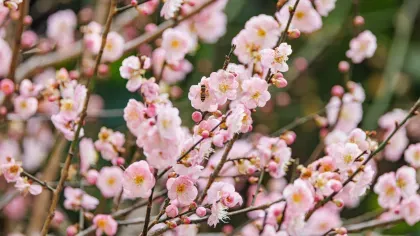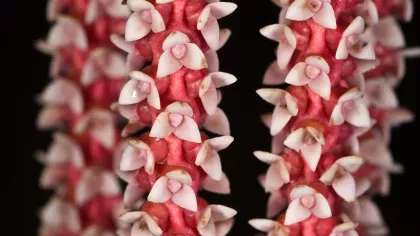11 August 2020
Plants you can find on the beach
A round up of our favourite plants that thrive in salty air, sandy soil and windy conditions.

The salt-laden winds, sandy soil and shifting ground at the beach present a challenging environment for plant life to survive.
But some hardy plants make their home in these conditions and thrive in them.
It's easy to overlook the amazing plant life under our noses in the UK, but with many of us going on staycation this year now is the time to take notice.
What plants you can spot on your next trip to the beach?
Grasses
Swaying beach grasses are a familiar site on the UK's coast.
Marram grass (Ammophila arenaria) grows in dense, spiky tufts. It has green spiky leaves, and is important in the formation of sand dunes.
Its matted roots help the sand dunes stay stable and grow big, and allows them to be colonised by other species of plants.
Adapted to harsh conditions, it has rolled leaves which protect it from drying out.
Lush, feathery pampas grass (Cortaderia selloana) is another common grass that grows on sand dunes.
Tolerant to drought, wind and salt sprays, the large silvery tufts are popular home decorations when dried.


Pine trees
The European black pine (Pinus nigra), maritime pine (Pinus pinaster) and stone pine are hardy trees that tolerate exposure to sea winds and can often be found growing in coastal woodlands.
Black pine is native to central and southern European coastal areas. It's a very resilient tree that can resist extreme temperatures, salt, drought, and even snow.
Stone pines, also known as the umbrella pine, are native to the Mediterranean and cope well with sandy soil. They can grow happily in the UK but do better in warmer countries like Portugal and Italy.
This is the tree that pine nuts come from. A primary ingredient in pesto, pine nuts are the edible seeds of the stone pine and are extracted from the cones.
Most pine nuts take around a year and a half to grow, but some can take up to 3 years, which is why they're so expensive to buy.

Common gorse
A shrub from the pea family, gorse (Ulex europaeus) thrives on heaths and coastal grasslands.
It has needle-like leaves and yellow flowers, and you'll often see it growing on cliffs and rocky areas.
If you get close up to the flowers you'll be able to smell a distinctive, coconut-like scent.
Gorse provides food and shelter for birds, particularly yellowhammers and stonechats.
Traditionally, gorse was collected and was used as fuel for bread ovens, food for livestock, and a material in chimney brushes.

Seaweed
Stroll by the water and you're bound to come across seaweed that's been washed up on the tide.
Seaweed is the common name for marine plants and algae that grow in water, and there are around 700 of species of seaweed found in UK waters.
They are technically not plants, but a type of algae.
Unlike land plants, they don't need roots or leaves to move nutrients and water into their bodies. Instead they survive by absorbing water and nutrients through their surface tissues from the water around them.
Some seaweeds are edible and nutritionally dense, and are a good source of iodine. They're used in health foods, supplements and skin care products. A jelly-like substance extracted from seaweed called agar agar is used as vegetarian gelatine.
Seaweed is a popular ingredient in Japanese cuisine, used in sushi rolls and miso soup.


Sea thrift
Sea thrift (Armeria maritima) has a variety of common names, such as 'sea pink' and 'rock rose'.
It grows on cliffs, sea shores and salt marshes, growing in low clumps with flowers ranging from white, purple and pink.
Thriving in poor and sandy soil, it's tolerant of salty sea air and has nectar-rich flowers which attract pollinators.
It's a colourful addition to gardens, particularly in rock gardens and areas with gravel or sandy soil.

Sea kale
Sea kale (Crambe Maritima) is native to the UK and Europe and grows on shingle beaches along our coastline.
It's mostly found on the south coast of England, and also in East Anglia, Wales and Scotland.
It has thick, waxy leaves with white clusters of honey-scented white flowers appearing in early summer. The young stems of sea kale are edible, and can be eaten steamed.
Sadly the flower is not as common as it once was. The construction of sea defences and loss of shingle habitats are thought to have contributed to the decline.
To learn how to grow sea kale in your own garden, pick up a copy of Gardening with Drought-Friendly Plants by Kew horticulturalist Tony Hall.
If you're staying in the UK for your holidays this year, head to Kew Gardens to satisfy your wonderlust.
If you go foraging for wild plants, never pick or eat anything unless you're absolutely certain of its identification.








